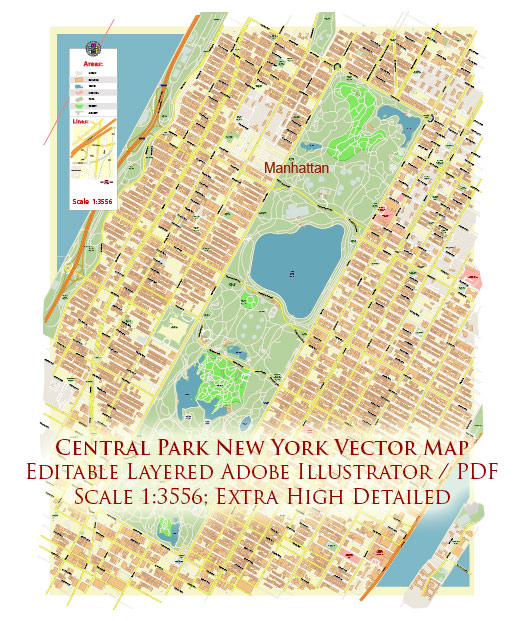Central Park in New York City is a masterpiece of landscape architecture and urban planning, designed by Frederick Law Olmsted and Calvert Vaux. It spans approximately 843 acres (341 hectares) and is located in the heart of Manhattan, between the Upper West Side and Upper East Side. Central Park is a key feature of the city, providing a haven of nature amidst the bustling urban environment.
Vectormap.Net provide you with the most accurate and up-to-date vector maps in Adobe Illustrator, PDF and other formats, designed for editing and printing. Please read the vector map descriptions carefully.
Here’s a detailed description of its landscape architecture:
- Naturalistic Design:
- Olmsted and Vaux aimed to create a naturalistic and picturesque landscape that appeared as though it were untouched by human hands.
- They incorporated a combination of open meadows, woodlands, lakes, and water bodies to achieve a diverse and harmonious environment.
- The Great Lawn:
- One of the iconic features of Central Park is the Great Lawn, a vast open space that hosts various recreational activities.
- The lawn is surrounded by trees and is a popular spot for picnics, sports, and cultural events.
- Water Bodies:
- Central Park includes several water bodies, such as the Jacqueline Kennedy Onassis Reservoir, the Central Park Lake, and the Turtle Pond.
- The water features provide visual interest, habitat for wildlife, and opportunities for boating and other water activities.
- Bridges and Arches:
- The park boasts numerous picturesque bridges and arches, each designed with unique architectural elements.
- Bow Bridge, Gapstow Bridge, and the Bethesda Terrace with its Minton Tile ceiling are notable examples.
- Woodlands and Ramble:
- The Ramble is a dense woodland area with winding pathways, designed to give visitors a sense of seclusion and discovery.
- This section of the park provides a contrast to the more open areas and encourages exploration.
- Formal Gardens:
- The Conservatory Garden is a beautifully landscaped formal garden featuring European-inspired design.
- It includes three distinct sections: the Italian Garden, the French Garden, and the English Garden, each with its own character.
- Statues and Monuments:
- Throughout Central Park, you’ll find statues and monuments dedicated to historical figures and events.
- Notable examples include the Alice in Wonderland statue, the Shakespeare Garden, and the Bethesda Fountain with its Angel of the Waters sculpture.
- Recreational Facilities:
- The park offers a wide range of recreational facilities, including playgrounds, sports fields, and courts for activities such as baseball, soccer, basketball, and tennis.
- Zoos and Conservatories:
- Central Park Zoo and the Central Park Conservatory Garden contribute to the diversity of experiences within the park.
- The zoo features a variety of animals, while the conservatory showcases seasonal flowers and plants.
- Preservation and Restoration:
- The Central Park Conservancy plays a vital role in maintaining and restoring the park’s landscapes and structures.
- Their efforts ensure that the original vision of Olmsted and Vaux is preserved for future generations.
Central Park’s landscape architecture seamlessly blends natural elements with carefully crafted design, offering a respite from the urban environment and providing a dynamic and ever-changing experience for visitors.


 Author: Kirill Shrayber, Ph.D.
Author: Kirill Shrayber, Ph.D.